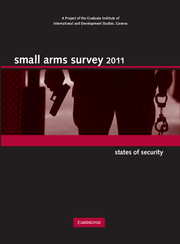Book contents
- Frontmatter
- Foreword
- Contents
- About the Small Arms Survey
- Notes to readers
- Acknowledgements
- Introduction
- Chapter 1 Larger but Less Known: Authorized Light Weapons Transfers
- Chapter 2 Fact or Fiction?: The UN Small Arms Process
- Chapter 3 Procurement and Policy: Police Use of Emerging Weapons Technology
- Chapter 4 A Booming Business: Private Security and Small Arms
- Chapter 5 Protected but Exposed: Multinationals and Private Security
- Chapter 6 Ethos of Exploitation: Insecurity and Predation in Madagascar
- Chapter 7 Reforming the Ranks: Public Security in a Divided Côte d'Ivoire
- Chapter 8 Securing the State: Haiti before and after the Earthquake
- Chapter 9 Balancing Act: Regulation of Civilian Firearm Possession
- Index
Chapter 3 - Procurement and Policy: Police Use of Emerging Weapons Technology
Published online by Cambridge University Press: 05 March 2012
- Frontmatter
- Foreword
- Contents
- About the Small Arms Survey
- Notes to readers
- Acknowledgements
- Introduction
- Chapter 1 Larger but Less Known: Authorized Light Weapons Transfers
- Chapter 2 Fact or Fiction?: The UN Small Arms Process
- Chapter 3 Procurement and Policy: Police Use of Emerging Weapons Technology
- Chapter 4 A Booming Business: Private Security and Small Arms
- Chapter 5 Protected but Exposed: Multinationals and Private Security
- Chapter 6 Ethos of Exploitation: Insecurity and Predation in Madagascar
- Chapter 7 Reforming the Ranks: Public Security in a Divided Côte d'Ivoire
- Chapter 8 Securing the State: Haiti before and after the Earthquake
- Chapter 9 Balancing Act: Regulation of Civilian Firearm Possession
- Index
Summary
Introduction
In most Western countries, two factors condition the use of force by domestic security agencies: operational guidelines and the type of weaponry available. The relationship between use-of-force policy and weapons procurement is close but complex. The adoption of new weapons may call for new policies, while the need to meet international norms in policing, for example, can affect weapons procurement. Market forces and trends in both civilian and military firearms development and procurement also play influential roles in the adoption of new weapons technology.
On the streets of cities such as Chicago, Manchester, and Marseille, police officers have increasingly adopted socalled ‘less-lethal’ weapons into their day-to-day activities. A comprehensive review of the use of these weapons by Western police has not yet been undertaken, but police experience in France, the United Kingdom, and the United States suggests that countries are facing similar use-of-force challenges that are drawing them to use these weapons. By examining recent trends in police weapons technology and procurement by law enforcement agencies, as well as their use-of-force policies, this chapter highlights the alignment of policies and practices in a small but important sample of the West's ‘leading-edge’ states.
Among the chapter's conclusions are the following:
Aside from the use of new materials to reduce weight and facilitate customization, law enforcement firearms have not recently experienced significant technological development.
[…]
- Type
- Chapter
- Information
- Small Arms Survey 2011States of Security, pp. 69 - 100Publisher: Cambridge University PressPrint publication year: 2011
- 1
- Cited by



